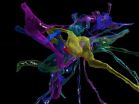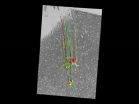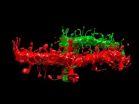(Press-News.org) A new imaging tool developed by Boston scientists could do for the brain what the telescope did for space exploration. In the first demonstration of how the technology works, published July 30 in the journal Cell, the researchers look inside the brain of an adult mouse at a scale previously unachievable, generating images at a nanoscale resolution. The inventors' long-term goal is to make the resource available to the scientific community in the form of a national brain observatory.
"I'm a strong believer in bottom up-science, which is a way of saying that I would prefer to generate a hypothesis from the data and test it," says senior study author Jeff Lichtman, of Harvard University. "For people who are imagers, being able to see all of these details is wonderful and we're getting an opportunity to peer into something that has remained somewhat intractable for so long. It's about time we did this, and it is what people should be doing about things we don't understand."
The researchers have begun the process of mining their imaging data by looking first at an area of the brain that receives sensory information from mouse whiskers, which help the animals orient themselves and are even more sensitive than human fingertips. The scientists used a program called VAST, developed by co-author Daniel Berger of Harvard and the Massachusetts Institute of Technology, to assign different colors and piece apart each individual "object" (e.g., neuron, glial cell, blood vessel cell, etc.).
"The complexity of the brain is much more than what we had ever imagined," says study first author Narayanan "Bobby" Kasthuri, of the Boston University School of Medicine. "We had this clean idea of how there's a really nice order to how neurons connect with each other, but if you actually look at the material it's not like that. The connections are so messy that it's hard to imagine a plan to it, but we checked and there's clearly a pattern that cannot be explained by randomness."
The researchers see great potential in the tool's ability to answer questions about what a neurological disorder actually looks like in the brain, as well as what makes the human brain different from other animals and different between individuals. Who we become is very much a product of the connections our neurons make in response to various life experiences. To be able to compare the physical neuron-to-neuron connections in an infant, a mathematical genius, and someone with schizophrenia would be a leap in our understanding of how our brains shape who we are (or vice versa).
The cost and data storage demands for this type of research are still high, but the researchers expect expenses to drop over time (as has been the case with genome sequencing). To facilitate data sharing, the scientists are now partnering with Argonne National Laboratory with the hopes of creating a national brain laboratory that neuroscientists around the world can access within the next few years.
"It's bittersweet that there are many scientists who think this is a total waste of time as well as a big investment in money and effort that could be better spent answering questions that are more proximal," Lichtman says. "As long as data is showing you things that are unexpected, then you're definitely doing the right thing. And we are certainly far from being out of the surprise element. There's never a time when we look at this data that we don't see something that we've never seen before."
INFORMATION:
This work was supported by the NIH/NINDS, Conte, the MURI Army Research Office, the NSF, DARPA, the Human Frontier Science Program, the JHU Applied Physics Laboratory, the Research Program for Applied Neuroscience, the Howard Hughes Medical Institute, Nvidia, Intel, and Google.
Cell, Kasthuri et al.: "Saturated Reconstruction of a Volume of Neocortex" http://dx.doi.org/10.1016/j.cell.2015.06.054
Cell, the flagship journal of Cell Press, is a bimonthly journal that publishes findings of unusual significance in any area of experimental biology, including but not limited to cell biology, molecular biology, neuroscience, immunology, virology and microbiology, cancer, human genetics, systems biology, signaling, and disease mechanisms and therapeutics. For more information, please visit http://www.cell.com/cell. To receive media alerts for Cell or other Cell Press journals, contact press@cell.com.
Oropharyngeal cancer patients who were found to have detectable traces of human papillomavirus type 16 (HPV16) in their saliva following cancer treatment are at an increased risk for recurrence, a study led by researchers at the Johns Hopkins Bloomberg School of Public Health has found.
The oropharynx is the area of the upper throat that includes the back of the tongue, the soft palate, the tonsils and the walls of the throat. Oropharyngeal cancer accounts for 2.8 percent of new cancers in the United States; it is often treated successfully with surgery.
In a small ...
In the last two decades, prosthetic limb technology has grown by leaps and bounds. Today, the most advanced prostheses incorporate microprocessors that work with onboard gyroscopes, accelerometers, and hydraulics to enable a person to walk with a normal gait. Such top-of-the-line prosthetics can cost more than $50,000.
Amos Winter is aiming to develop a passive, low-tech prosthetic knee that performs nearly as well as high-end prosthetics, at a fraction of the cost.
"We're going after this disruptive opportunity," says Winter, an assistant professor of mechanical ...
NEW YORK, July 30, 2015 - Major achievements have been made in the domestic HIV/AIDS response as a result of increased realignment and coordination of efforts at the federal level. However, that level of consistent coordination and alignment has yet to take place in most states. In an effort to identify what needs to be done, amfAR, The Foundation for AIDS Research, in collaboration with the National HIV/AIDS Initiative at the O'Neill Institute for National and Global Health Law at Georgetown Law, has released a set of recommendations for how states across the U.S. can ...
BUFFALO, N.Y. - A little recognition for a job well done means a lot to children with Attention Deficit/Hyperactivity Disorder (ADHD) - more so than it would for typically developing kids.
That praise, or other possible reward, improves the performance of children with ADHD on certain cognitive tasks, but until a recent study led by researchers from the University at Buffalo, it wasn't clear if that result was due to heightened motivation inspired by positive reinforcement or because those with ADHD simply had greater room for improvement at certain tasks relative to ...
The presence of persistent human papillomavirus (HPV) type 16 DNA in oral rinses after treatment for HPV-related oropharyngeal cancer was rare but it appears to be associated with poor prognosis and therefore may have potential as a long-term tool for tumor surveillance, according to an article published online by JAMA Oncology.
HPV infection is responsible for the majority of oropharyngeal carcinomas in the United States. In 10 percent to 25 percent of patients with HPV-positive tumors, the cancer will progress after treatment and earlier diagnoses of progressive or ...
(Boston)--New evidence highlights the importance of the liver in immunity against bacterial pneumonia. The study is the first of its kind to directly show such a link between liver-produced molecules and pneumonia susceptibility during sepsis.
Led by researchers at Boston University School of Medicine (BUSM), the study appears in the journal Infection and Immunity.
Pneumonia, according to the World Health Organization, is the leading infectious cause of death in children worldwide, taking more than 900,000 lives of children under the age of 5 in 2013 alone. Pneumonia, ...
A new piece of research led by the University of Southampton has found that the behaviour of fruit flies, which are commonly used in laboratory experiments, is altered by electric fields.
The research indicates that the wings of the insects are disturbed by static electric fields, leading to changes in avoidance behaviour and the neurochemical balance of their brains.
The paper, published in the Proceeding of the Royal Society B, suggests that the plastic housing laboratory fruit flies are commonly kept in (which hold their own static electric charge) could agitate the ...
In a survey of hospital medical physicians across the United States, women made nearly $15,000 less than their male counterparts, with a portion of this disparity explained by female doctors' tendency to prioritize collegiality and control over personal time, rather than substantial pay. The figure was determined after controlling for a number of factors, including age, geography, specialty, and amount and type of clinical work.
Optimal workload was the top priority for both male and female physicians, 776 of whom responded to survey questions on work priorities. Substantial ...
A new study led by a University of York scientist addresses an important question in climate science: how accurate are climate model projections?
Climate models are used to estimate future global warming, and their accuracy can be checked against the actual global warming observed so far. Most comparisons suggest that the world is warming a little more slowly than the model projections indicate. Scientists have wondered whether this difference is meaningful, or just a chance fluctuation.
Dr Kevin Cowtan, of the Department of Chemistry at York, led an international study ...
July 30, 2015 - Some women with breast cancer can now undergo a "one and done" approach combining nipple-sparing mastectomy with immediate single-stage implant (SSI) breast reconstruction in a single procedure, according to a report in the July issue of Plastic and Reconstructive Surgery®, the official medical journal of the American Society of Plastic Surgeons (ASPS).
In the article, ASPS Member Surgeon Dr. Mark A. Codner of Emory University, Atlanta, shares his approach to single-stage implant (SSI) breast reconstruction after mastectomy for breast cancer. Coauthor ...


